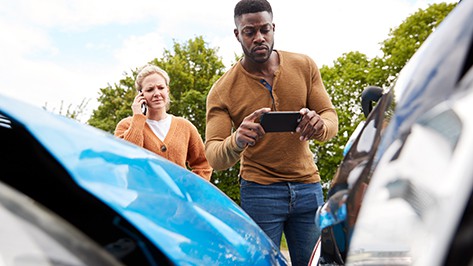
One of the most pressing concerns we’ve addressed at the Law Office of Carlos L. Williams revolves around post-accident actions. Many individuals, often in a state of panic or confusion, wonder: “Is leaving the scene of an accident considered a felony in Oklahoma?” The answer varies depending on the details of the incident. In Oklahoma, if an accident leads to considerable property damage, personal injury, or, in the worst cases, a fatality, and one leaves the scene without reporting, it can be treated as a felony.
Such a felony carries with it significant legal penalties, including possible imprisonment and hefty fines. Furthermore, it can deeply tarnish one’s personal and professional reputation. As such, it is paramount to have expert legal guidance if faced with this predicament. Based in Tulsa, OK, Accident Attorney Carlos Williams has built a reputation for his thorough understanding of accident-related laws and his unwavering commitment to his clients. Engaging an experienced accident attorney early can make a world of difference.
Oklahoma has enacted laws against leaving the scene of an accident, sometimes referred to as a “hit and run” laws. There are essentially three categories of leaving the scene of an accident:
There is a statutory duty that prescribes the driver of any vehicle involved in an accident causing injury, death, or damage shall furnish all his or her correct information to the other driver.[1] There is also a duty to render reasonable assistance to any person injured in the accident.[2]
Information an individual is required to furnish to the other driver: “correct name, address and registration number of the vehicle he is driving, and shall upon request exhibit his driver license and his security verification form.”
Any driver who provides information required by this section which is intentionally inaccurate shall be subject to the provisions of Section 10-103.[shall be guilty of a misdemeanor and upon conviction thereof shall be punished by a fine not to exceed Five Hundred Dollars ($500.00) or by imprisonment in the county jail for not more than one (1) year, or by both such fine and imprisonment.]
Under each of the three circumstances listed above, a person should immediately stop the vehicle at the scene or as close as possible to exchange information with the other driver. Every stop should be made without obstructing traffic more than is necessary. Failure to do so will result in violation of the statute and will carry penalties, as referenced below.
Any person willfully, maliciously, or feloniously failing to stop to avoid detection or prosecution or to comply with said requirements under such circumstances, shall upon conviction be guilty of a felony punishable by imprisonment for not less than ten (10) days nor more than two (2) years, or by a fine of not less than Fifty Dollars ($50.00) nor more than One Thousand Dollars ($1,000.00), or by both such fine and imprisonment.[3]
Any person willfully, maliciously, or feloniously failing to stop to avoid detection or prosecution, or to comply with said requirements under such circumstances, shall upon conviction be guilty of a felony punishable by imprisonment for not less than one (1) year nor more than ten (10) years, or by a fine of not less than One Thousand Dollars ($1,000.00) nor more than Ten Thousand Dollars ($10,000.00), or by both such fine and imprisonment.[4]
Any person failing to stop or comply with said requirements under such circumstances shall be guilty of a misdemeanor and upon conviction thereof shall be punished by a fine not to exceed Five Hundred Dollars ($500.00) or by imprisonment in the county jail for not more than one (1) year, or by both such fine and imprisonment. In addition to the criminal penalties imposed by this section, any person violating the provisions of this section shall be subject to liability for damages in an amount equal to three times the value of the damage caused by the accident. Said damages shall be recoverable in a civil action. Nothing in this section shall prevent a judge from ordering restitution for any damage caused by a driver involved in an accident provided for in this section.[5]
There have been creative challenges to the statues above. In the case of Lamb v. State, John William Lamb left the scene of an accident and was later convicted by a jury.[6] In his appeal, among other issues raised, the defendant claimed the statutory requirement to exchange information with the other driver violated his constitutional privilege against self-incrimination. In finding against the defendant, the Court cited a then recent Supreme Court case that heard a similar challenge to a California statute. In that case, the Supreme Court held “the statute is essentially regulatory, not criminal…[the statute]was not intended to facilitate criminal convictions, but to promote the satisfaction of civil liabilities arising from automobile accidents”.[7]The Court held the statute requiring the exchange of correct information did not violate defendant’s privilege against self-incrimination under either the United states Constitution, or Article II, Sections 7 and 21, of the Oklahoma State Constitution.
If you have a question regarding Oklahoma traffic laws: CDL violations , Speeding Tickets, How Points are Assessed, Texting While Driving, and other Traffic Tickets, call our office for a consultation.
[1] O.S. § 47, 10-104(A).
[2] Id.
[3] O.S. § 47, 10-102(B).
[4] O.S. § 47, 10-102.1(B).
[5] O.S. § 47, 10-103.
[6] Lamb v. State, 1971 OK CR 342.
[7] Id. citing California v. Byers, 402 U.S. 424 (1971).

About the Author Carlos Williams & Associates, PLLC is a firm that services the Oklahoma community.
Over the years, we have demonstrated our skills and expertise as a leading single
source for legal support throughout Oklahoma. Request A Consultation